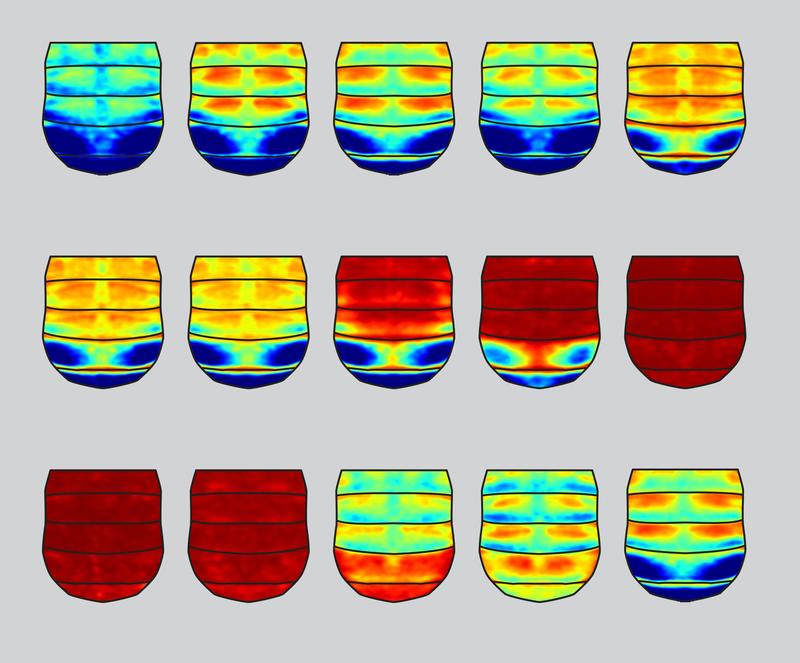Study on gene regulation with surprising results
Some sequences in the genome cause genes to be switched on or off. Until now, each of these gene switches, or so-called enhancers, was thought to have its own place on the DNA. Different enhancers are therefore separated from each other, even if they control the same gene, and switch it on in different parts of the body. A recent study from the University of Bonn and the LMU Munich challenges this idea. The findings are also important because gene switches are thought to play a central role in evolution. The study has been published in the journal Science Advances.
The blueprint of plant and animal forms is encoded in their DNA. But only a small part of the genome - about two percent in mammals - contains genes, the instructions for making proteins. The rest largely controls when and where these genes are active: how many of their transcripts are produced, and thus how many proteins are made from these transcripts.
Some of these regulatory sequences, called 'enhancers', work like dimmer switches used to modulate the light in our living room. Indeed, they specifically increase the expression of a particular gene, where and when this gene is required. Genes controlling morphology often respond to several independent enhancers, each determining the expression of the gene in a different body part.
Enhancers controlling Drosophila colouration
Until now, enhancers were thought to be modular. The term implies that each enhancer occupies an isolated stretch of DNA. “We have shown, however, that this is not absolutely true," explains Mariam Museridze. She is a PhD student at the Bonn Institute of Organismic Biology in the group of Prof. Dr. Nicolas Gompel and the first author of the study. Gompel is also a member of the Transdisciplinary Research Area (TRA) 'Life & Health' at the University of Bonn.
The researchers studied how a gene called yellow is regulated in the fruit fly Drosophila. This gene causes the insect to produce the brownish pigment melanin. There are a number of enhancers that control the activity of yellow. One of them, for example, is responsible for the pigmentation of the maggots' teeth, while another is responsible for the formation of the striped pattern on the fly's abdomen.
“We have taken a closer look at two of these enhancers," says Museridze. The first controls the formation of colour pattern on the wings, while the second controls the colouring of the head, thorax and abdomen. Both are active at the same time during the fly's metamorphosis. The team discovered that the body enhancer is not, as expected, located in a different region of DNA from the wing enhancer. Instead, there are extensive regions of DNA that belong to both gene switches, i.e. they influence the pigmentation of both the wing and the body.
The results suggest that the architecture of regulatory sequences in the genome is much more complex than previously thought. This has far-reaching implications for how traits change during evolution. According to current knowledge, enhancers play a key role in this process.
Enhancers as an evolutionary playground
This is because many proteins are so important to an organism that a mutation in their gene (i.e., the DNA sequence that contains the instructions for building the protein) would cause serious problems or even certain death. As a result, genes that control body shape, such as the number of wings or legs, rarely change over the course of evolution. Enhancers offer a way out of this dilemma: when they mutate, the activity of the corresponding gene changes, but only in a specific tissue and at a specific time.
“The cost of mutating an enhancer is therefore often lower than the cost of mutating the gene directly," says Mariam Museridze. This makes it easier for new traits to emerge during evolution. It is like baking a cake: If you mix eggs, flour, milk and sugar, you can get completely different types of dough, depending on the mixing ratio. In this metaphor, the enhancers would be responsible for the quantity of ingredients, not the type of ingredients.
A genetic mutation is like accidentally replacing one ingredient with something completely different - for example, using sawdust instead of flour. The result will certainly not taste very good. A mutation in an enhancer, on the other hand, would change the amount of flour. “If enhancers are not as modular as we thought, this means that mutations in them can have much broader effects," says Museridze. This means that such a mutation could affect the amount of several ingredients at the same time. However, it is also possible that the enhancers retain their independence and continue to control the amount of a single ingredient, even though their sequences are interwoven and shared. “We now want to investigate these possibilities in more detail,” explains Professor Gompel. “We also want to find out how general our findings are and how this affects our understanding of evolutionary mechanisms.”
Participating Institutions and funding:
Prof Gompel and his research group began their study at the LMU Munich and completed it at the University of Bonn. The University of California at Davis, USA, was also involved in the research. The study was funded by the German Research Foundation (DFG) and the LMU Munich.
Wissenschaftlicher Ansprechpartner:
Prof. Dr. Nicolas Gompel
Bonn Institute of Organismic Biology
University of Bonn
Phone: +49 228 73-4784
E-Mail: ngompel@uni-bonn.de
Mariam Museridze
Bonn Institute of Organismic Biology
University of Bonn
E-Mail: mmuserid@uni-bonn.de
Originalpublikation:
Mariam Museridze, Stefano Ceolin, Bettina Mühling, Srishti Ramanathan, Olga Barmina, Pallavi Santhi Sekhar, Nicolas Gompel: Entangled and non-modular enhancer sequences producing independent spatial activities; Science Advances;
DOI: https://doi.org/10.1126/sciadv.adr9856
Die semantisch ähnlichsten Pressemitteilungen im idw


